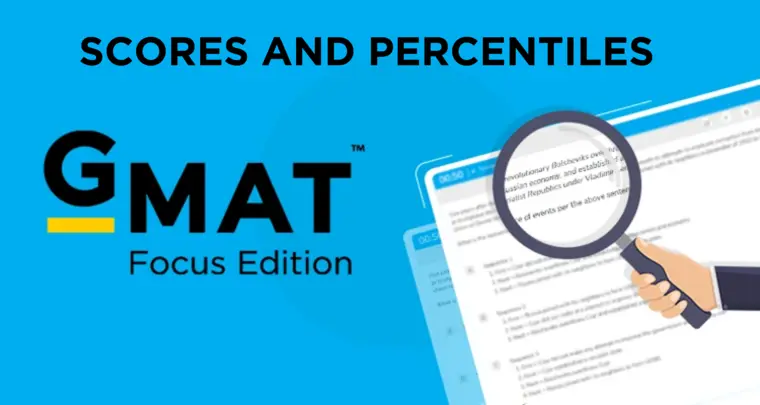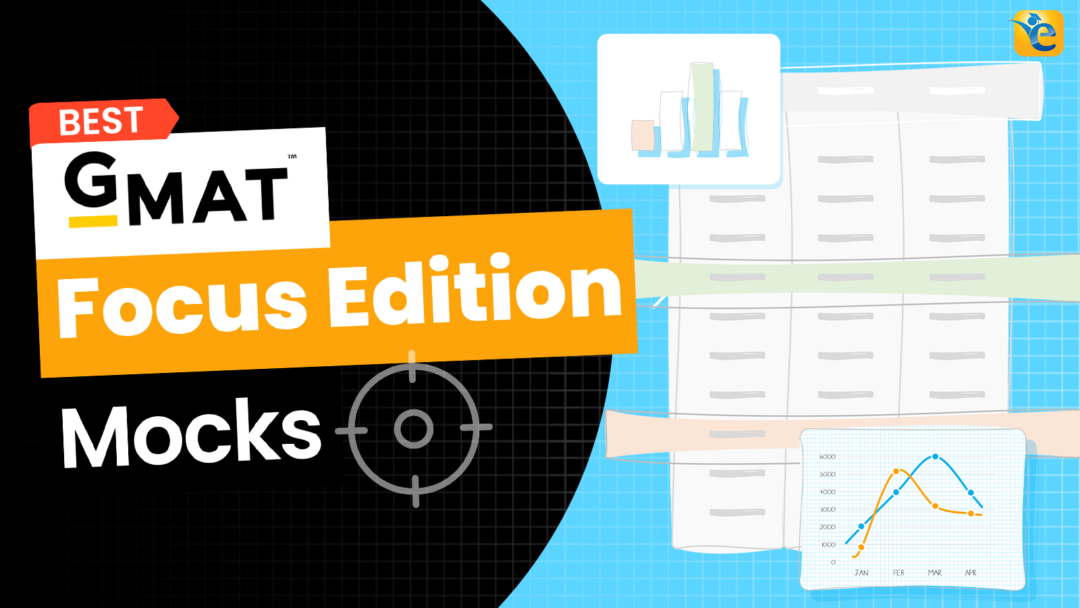The Graduate Management Admission Council (GMAC) has officially revealed the highly anticipated GMAT Focus score chart and percentiles and the scoring scale for the GMAT Focus, a revolutionary approach to evaluating candidates for business schools. This innovative scoring system promises a fairer, more comprehensive assessment of applicants’ abilities. If you’re considering taking the GMAT Focus, this article will provide you with essential insights into the GMAT Focus edition’s score chart and percentiles, the groundbreaking scoring architecture, and how it could impact your test-taking experience.
In addition to detailing the new scoring scale, this article also outlines the key dates applicable for the new exam, ensuring you’re well-prepared for the next chapter in your educational journey.
The best way to understand the new GMAT scoring system is by trying the test out for yourself, and get a detailed score analysis report.
Here are the key takeaways explained in this article:
- New and more discerning scoring architecture: The test is scored from 205 to 805 – with 61 different ability levels, the same number of levels that are there in the classic GMAT (200 to 800). However, with 40% more levels allocated to high scorers, the Focus edition provides more granular scores to high scorers (Section 1) and does more justice to their hard work (in our opinion). You will get GMAT score chart for the total score as well as for each section separately
- Three vs. Two Sub-sections: The total score is composed of three subsection scores (Quant, Verbal, and Data Insights) – each of which is weighted equally and has scaled scores from 60 to 90. This is different from the classic GMAT, where the score out of 800 is composed of two subsections (Quant and Verbal).
- Fixes the mess with Quant scoring: By assigning 11 scoring levels (3X as many compared to the classic GMAT) to the top 40% of all test takers, the GMAT Focus Edition delivers a more accurate assessment of test takers’ Quant ability.
- Classic GMAT vs GMAT Focus Edition: The GMAT score translation chart rewards higher percentiles to high scorers, probably because GMAT Focus Edition’s scoring architecture is more granular for high GMAT. This trend reverses for low scorers.

- New and more discerning scoring architecture
- What is the GMAT Score range?
- How is GMAT scored?
- GMAT percentile- How to convert your score into percentile ranking?
- Major differences in how the exam is scored
- Classic GMAT vs GMAT Focus Edition- Scoring Architecture
- What are the changes in the Official Score Report for the GMAT Focus Edition?
- Overall Summary | GMAT Focus Score Chart & Percentile
- GMAT Focus OFFICIAL prep materials
- FAQ
Ready to tackle the GMAT Focus Edition? e-GMAT offers a Personalized Study Planner and top-notch Free GFE mock exam to help you prepare effectively. As the most reviewed GMAT prep company on GMAT Club with 2600+ reviews we’re here to support your GFE journey. Take advantage of our free trial with the best quality content. Start your path to success today!
New and more discerning scoring architecture | GMAT Focus Score Chart
The new GMAT Focus Edition, while introducing several innovative features, also shares some similarities with the classic GMAT exam’s scoring system. Both versions of the test have 61 scoring levels, providing a comprehensive assessment of candidates’ abilities. Additionally, the GMAT Focus Edition’s total score ranges from 205 to 805, which is a slight modification from the GMAT Exam’s total score range of 200 to 800. This change allows for easier differentiation between GMAT Focus Edition and GMAT Exam scores.
What is the GMAT Score range?
| Number of Ability levels | Score Scales | |
| GMAT Focus Edition | 61 | 205 – 805 |
| Classic GMAT | 61 | 200 – 800 |
There are three sections in the new GMAT i.e., Quant or Quantitative, Verbal, and Data Insights. You get a scaled score for each of the sections . Here is the table with GMAT score breakdown:
| New GMAT Section | Scaled Score | Mean Score |
| Quantitative score | 60 – 90 | 77.71 |
| Verbal score | 60 – 90 | 78.99 |
| Data Insights | 60 – 90 | 74.41 |
How is GMAT scored?
The most important thing you need to understand is that the GMAT is an adaptive test. This means that the difficulty level of questions keeps changing according to your performance. For example, the test might keep increasing the difficulty level of questions if you keep answering them correctly.
But why does the test adjust the difficulty level of questions?
For one simple reason, it wants to assess your ability level. A person who can answer higher difficulty level questions has a high ability level as compared to one who is not able to answer those questions. Therefore, your GMAT score depends on two factors:
- Number of questions answered correctly
- The average difficulty level of questions answered correctly
GMAT percentile- How to convert your score into percentile ranking?

Here’s what the GMAC says about GMAT Scores and GMAT percentiles: “GMAT Scores also include a Percentile Ranking. This number indicates the percentage of test-takers that you performed better than.”
They further explain that while your score will not change, the Percentile Ranking may as GMAT Percentiles are recalculated every summer using exam data from the prior three years.
The percentile associated with a GMAT score is the percentage of people whom you have outscored by getting that score.
Take a look at the table (GMAT Score Chart) below to understand the relation between GMAT Test Scores and GMAT Percentiles.
GMAT Scores & percentiles :
1) Total Score sorted by Percentile Ranking:
Use this GMAT Score Chart (updated January 2024) to understand the corresponding percentile values for total GMAT scores :
2) Quantitative reasoning Score sorted by Percentile Ranking:
Use this GMAT Score Chart (updated January 2024) to understand the corresponding percentile values for GMAT Quant scores :
3) Verbal reasoning Score sorted by Percentile Ranking:
Use this GMAT Score Chart (updated January 2024) to understand the corresponding percentile values for GMAT Verbal scores :
4) Data Insights Score sorted by Percentile Ranking:
Use this GMAT Score Chart (updated January 2024) to understand the corresponding percentile values for GMAT Data Insight scores :
Data Insig
Will the GMAT Focus Percentile change? Read this article to know about it.
Major differences in how the exam is scored
The GMAC has introduced a much-needed overhaul to the GMAT Focus Edition's scoring system, including an update to the scoring algorithm, adapting it to the increasingly diverse and global test-taking population. Over the years, significant shifts in scores have led to uneven distribution, making it challenging for schools to differentiate candidate performance. The updated score scale addresses this issue, ensuring a more equitable assessment that accurately reflects the evolving composition of the GMAT test-takers. There are two major changes to the scoring architecture.
- The Total Score is now comprised of all 3 section scores (Quantitative, Verbal, and Data Insights), ensuring a more comprehensive assessment. This is explained in point 2.
- The scoring scale has evolved and assigns more ability levels to higher scoring levels, making overall scoring more in tune with the current test-taking population.
Evolved scoring scale = More balanced Scoring
The classic GMAT is scored from 200 to 800 in 10-point intervals. This means that it has 61 scoring levels. The GMAT Focus Edition also has 61 scoring levels and is scored from 205 to 805. However, the scoring scale for the classic GMAT was designed in the 1990s. With the GMAT Focus Edition, the GMAC has used this opportunity to enhance this scoring scale to align it with the needs of the current test-taking population.
| GMAT Focus Edition | Classic GMAT | |||
| Segment | Number of Ability points | %age ability points | Number of Ability points | %age ability points |
| 76-100 percentile | 20 (+6) | 33% | 14 | 23% |
| 51 to 74 percentile | 6 | 10% | 6 | 10% |
| 26 to 50 percentile | 6 (-3) | 10% | 9 | 15% |
| 0 to 25 percentile | 29 (-3) | 48% | 32 | 52% |
Did you know 9 out of 10 MBA Admissions decisions are made using a GMAT score? We can give you access to quality online content to prepare for GMAT Focus. We are the most reviewed GMAT prep company on the GMAT club with more than 2700+ reviews and have delivered 10x 700+ scores than the average GMATClub partner. Why don’t you take a free trial and judge it for yourself?
The table above compares the number of ability points assigned to various percentile segments in GMAT Focus vs. the classic GMAT. The GMAT Focus edition assigns 20 ability points to the top 25 percentile of test takers. This is 40% more ability points than the classic GMAT. This means that the GMAT Focus edition can do a much more precise assessment of your ability than the classic GMAT. Most of this improvement has come from two changes:
- A much-improved Quant scoring architecture
- A balanced scoring Data Insights scoring architecture.
Another major addition to the GMAT Focus is the inclusion of a 100 percentile score. This is a major change from the classic GMAT, where even a score of 800 mapped to the 99th percentile. In fact, as per the current scoring table, any score above 735 results in a 100 percentile score.
Do these ability levels do much good?
If you look at the score chart below, you will observe that 11 out of the 20 levels are assigned to 100 percentile scorers or 99 percentile scorers, indicating that these expanded levels may not yield many benefits to most high scorers.
While this may mathematically seem true on paper, it ignores two key aspects:
- This data is built around the stats the GMAC currently has, especially the stats for IR. Since most people currently don’t prepare for IR, those stats are likely to change, which in turn will change the percentiles that these ability levels map to.
- Even with these IR stats, the GMAC has a conclusive way to distribute the top 25 percentile of test takers into 20 different buckets. The classic GMAT’s scoring architecture only allows 14 such buckets.
We strongly believe that the score chart for the Data Insights section will undergo a considerable change in the near future, allowing many more people to score higher, which in turn would allow more individuals to perform better on GMAT Focus Edition. In other, while a 745 on GMAT Focus today is a 100th percentile score, it may well become a 99th or even a 98th percentile score in the near future.

Revamped Quant Scoring architecture
Here is an interesting fact for you: The quant section of the classic GMAT has 46 ability levels from 6 to 51. In other words, if the testing items had infinite granularity and we could run the test for as long as we wished, we would be able to assign one ability level to 100/46 = 2.17 percent of students. The current test and its corresponding scoring fail miserably on that expectation. Please see the score chart below as evidence.
| Classic GMAT Scaled Score (out of 60) | Percentile Ranking |
| 51 | 97% |
| 50 | 87% |
| 49 | 73% |
| 48 | 65% |
| 47 | 57% |
As the table above shows, the classic GMAT’s Quant scoring has exactly 4 ability levels for the top 40% of students. This is despite the fact that the test currently has 31 questions – or about 50% more questions than planned for the Focus Edition. In other words, a student whose ability is estimated to be 90th percentile will likely get a Q50, the same score that an 85th percentile. Similarly, someone at the 79 percentile is likely grouped with someone with the 71st percentile since both of them will likely be assigned a Q49 score.
By grouping all of these together, the test does not do justice to test takers.
Compare this to the Quant scoring table for the Focus Edition. Even though the Focus Edition has 21 questions or about 10 fewer than the classic GMAT, it assigns 10 ability levels for the top 30 percentile of students – or about 3X as many levels. Moreover, the test now conclusively differentiates between a 95th and a 97th percentile student, assigning them different scores.
| Scaled Score | Percentile |
| 90 | 100% |
| 89 | 97% |
| 88 | 95% |
| 87 | 94% |
| 86 | 92% |
| 85 | 89% |
| 84 | 85% |
| 83 | 81% |
| 82 | 76% |
| 81 | 71% |
Ready to tackle the GMAT Focus Edition? e-GMAT offers a Personalized Study Planner and top-notch Free GFE mock exam to help you prepare effectively. As the most reviewed GMAT prep company on GMAT Club with 2700+ reviews we’re here to support your GFE journey. Take advantage of our free trial with the best quality content. Start your path to success today!
Why do we need more granularity for high scorers?
| Classic GMAT | GMAT Focus Edition | Takeaway | |
| 90th percentile | 1 level | 5 levels | 1)Better scoring in GMAT Focus 2)GMAT Focus test is harder |
| 80th percentile | 1 level | 3 levels | 1)Better scoring in GMAT Focus 2)GMAT Focus test is harder |
| 70th percentile | 1 level | 2 levels | |
| 60th percentile | 1 level | 1 level | Similar behavior in both versions |
| Below 60th percentile | 42 levels | 20 levels |
| Overall | |
| GMAT Focus Edition | 11 out of 31 levels(60-90) - 60th percentile or more |
| GMAT classic Edition | 4 out of 46 levels(6-51) - 60th percentile or more* |
*Refer to the section Evolved scoring scale = More balanced Scoring for more information on ability levels
The table above compares the granularity of the Quant score for GMAT Focus Edition and the classic GMAT. One question that you may ask is – why we need higher granularity for high scorers when clearly it comes at the expense of lower granularity for those with lower percentile.
Let us illustrate this with an example:
Let us take a scoring paradigm in which one percentile = 1000 students. Furthermore, let us take two students, John and Jay.
- John's actual ability is 98th percentile. However, given the limitation of the scoring scale, he is assigned a 96th percentile score.
- Jay’s actual ability is 72nd percentile. However, given the limitation of the scoring scale, he is assigned a 70th percentile score.
While the overall error for both John and Jay is two percentile points, which translates to 2000 students, the overall ranking error is very different.
Here is the definition of ranking error = ABS (Assigned rank – Real Rank)/ (100-Rank)
The test tells John that there are 4000 students who are at the same level or ahead than him. However, in reality, only 2000 students should have been ahead of him. In other words, to the outside world (B-schools), there are twice as many students who are just as good or better than John. Hence, his ranking error is (2000/2000) 100%.
However, for Jay, the test tells that there are 30,000 students who are just as good or better than Jay, whereas the real number is 28,000. In other words, the error percentage of his rank is 2000/28,000 = 1/14 = 7%
So even though the error in ability estimation for both John and Jay was 2 percentage points, the overall ranking error was 15X as high for John as for Jay, making the test much more unfair to John.
Classic GMAT vs GMAT Focus Edition- Scoring Architecture
When you receive a GMAT™ Focus Edition Official Score Report, you may wonder how to compare the competitiveness of a candidate with a GMAT™ Focus score to one with a score from the previous GMAT™ Exam. According to the GMAC, due to changes in both score scales and score scale distribution, a direct comparison of total scores or section scores between the two exam versions is not meaningful. However, you can link and compare exam scores using percentile information. To do this comparison, the GMAT provides a Score Concordance Table.
Here are some observations from the table below:
- The mean score for the GMAT Focus Edition is 546.01 – much lower than the mean score for the classic GMAT (574.51)
- For scores above the 60th percentile, the GMAT Focus Percentiles are always higher than the corresponding percentiles of the classic GMAT. For scores lower than the 60th percentile, in pure percentile terms, students score higher on the classic GMAT than on the Focus Edition.
The GMAT Focus Edition began on November 7, 2023, and is currently the only version available. The classic version has been unavailable since February 1, 2024.
What are the changes in the Official Score Report for the GMAT Focus Edition?
The GMAT Focus Edition includes new and improved detailed performance insights with your Official Score Report, at no additional cost!
In addition to your total and section scores and percentile rankings, you’ll get insights by section, question type, and content domain (meaning, a specific area of knowledge), details on your time management, and data on how you performed compared to others that applied to the same program.
Performance summary charts provide a view into your performance across the entire exam:
- Performance by Section – provides an overview of your Total Score, section scores, and your percentile ranking for each.
- Performance by Program & School – shows your Total Score percentile ranking compared to the percentile rankings of test takers who sent their GMAT scores to the same program within the past 5 years.
Subsection charts provide details about how you performed on specific domains within the Verbal Reasoning, Quantitative Reasoning, and Data Insights sections. It is important to note that not all subdomains are present within each of the three sections. (Please note that if a specific chart is not relevant to a particular section, it will not be provided.)
- Performance by Content Domain - shows your percentile ranking based on the most recent 5 years of data for each content domain within the individual section.
- Performance by Question Type - shows your percentile ranking based on the most recent 5 years of data for each question type within the individual section.
- Performance by Fundamental Skills - shows your percentile ranking based on the most recent 5 years of data for each fundamental skill within the individual section.
- Time Management & Performance - shows your response time in minutes, including any review time, for each question within the individual section.
- Summary of Question Review & Changes - shows your review activity for that section, including how much time you spent reviewing and editing questions in the section.
Accessing Your Official Score Report
Your Official Score Report is available via your mba.com account typically within 3-5 business days*. You will be notified via email once your Official Score Report is available in your mba.com account (if you do not see the email, check your "junk mail" or "spam" folder). It includes your exam appointment details, some personal data that was provided at registration, individual section scores, Total Score, and percentile rankings. It will also include previous scores from other GMAT exams taken within the past five years (if applicable).
There is no need to cancel your score for the GMAT Focus Edition.
Since you are not required to select which business school programs receive your Official Score Report before you take the GMAT Focus Edition, there will never be a need to cancel your score. You only send the scores you want to, and if you do not send your Official Score Report to schools after the exam, they will not be able to see it. It will only remain accessible via your mba.com account for you to view.
Please note that once you send your score to a program, GMAC cannot undo that action or disable the school's ability to view your score.
Overall Summary | GMAT Focus Score Chart & Percentile
The GMAT Focus Edition introduces major scoring changes that favor high scorers, offering a more precise assessment of their abilities. By fixing the quant scoring, it aligns the scoring with the needs of test-takers, ensuring a more accurate evaluation. By equally weighing each section - DI, Quant, and Verbal, it ensures that those strong in either quant or verbal will have a similar opportunity to ace the test provided they work towards it. While it is uncertain if the test would be easier to prepare for, the new scoring system indicates that it would be a more fair assessment of candidates' abilities.
GMAT Focus OFFICIAL prep materials
Official GMAT prep resources, including the Official Guide for GMAT Focus (Official Guide 2023) and full-length practice tests, became available on mba.com on June 6, 2023. In addition, every e-GMATer can access an industry-leading GMAT Focus Course with 1000+ questions and free mock test , and it will help you understand the GMAT focus syllabus better through practice.
Read this article to understand about the GMAT Official Prep content – What is it & How to use it.
GMAT Focus prep resources offered by e-GMAT:
Here is the overview of the GMAT prep material offered by e-GMAT:
- Comprehensive GMAT Focus Materials: We've updated our courses with GMAT Focus Edition content, allowing existing students to access these new resources without extra costs, ensuring continuity in quality education and support.
- Data Insights (Scholaranium) : In our continuous effort to provide you with unparalleled preparation material, DI Scholaranium brings to you a whopping 350 questions, each meticulously crafted and paired with solutions, dedicated to data insights. This is in addition to the existing 500 questions available in the DI course, summing up to a total of 850 original questions.
- GMAT Focus Mocks : We at e-GMAT are immensely proud to announce a groundbreaking advancement in GMAT preparation with the launch of our GMAT Focus Edition mocks, developed from extensive research and simulations, these mocks promise to deliver a test experience that closely mirrors the actual exam.
- Personalized Study Planner : We have created the data-driven Personalized Study Planner for the GMAT Focus Edition, offering customized study schedules, performance forecasts, and trackable goals to effectively navigate the updated exam demands.
Begin your GMAT Focus preparation with the only prep company that has delivered more 700+ scores than any other GMAT club partner. Achieve GMAT 705+ with our AI driven tools that give you personalized feedback at every step of your GMAT journey. Take our free trial today!
FAQ
Scores from the previous version of the GMAT Exam will continue to be valid for 5 years from your appointment date.
You can score anywhere between 205 and 805 on the New GMAT.











